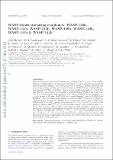Files in this item
WASP-South transiting exoplanets: WASP-130b, WASP-131b, WASP-132b, WASP-139b, WASP-140b, WASP-141b and WASP-142b
Item metadata
| dc.contributor.author | Hellier, C. | |
| dc.contributor.author | Anderson, D. R. | |
| dc.contributor.author | Cameron, A. Collier | |
| dc.contributor.author | Delrez, L. | |
| dc.contributor.author | Gillon, M. | |
| dc.contributor.author | Jehin, E. | |
| dc.contributor.author | Lendl, M. | |
| dc.contributor.author | Maxted, P. F. L. | |
| dc.contributor.author | Neveu-VanMalle, M. | |
| dc.contributor.author | Pepe, F. | |
| dc.contributor.author | Pollacco, D. | |
| dc.contributor.author | Queloz, D. | |
| dc.contributor.author | Ségransan, D. | |
| dc.contributor.author | Smalley, B. | |
| dc.contributor.author | Southworth, J. | |
| dc.contributor.author | Triaud, A. H. M. J. | |
| dc.contributor.author | Udry, S. | |
| dc.contributor.author | Wagg, T. | |
| dc.contributor.author | West, R. G. | |
| dc.date.accessioned | 2017-03-15T10:30:13Z | |
| dc.date.available | 2017-03-15T10:30:13Z | |
| dc.date.issued | 2017-03 | |
| dc.identifier | 249376845 | |
| dc.identifier | 356cea3f-a715-4636-984f-787aeb7e96e9 | |
| dc.identifier | 85014612864 | |
| dc.identifier | 000395165900079 | |
| dc.identifier.citation | Hellier , C , Anderson , D R , Cameron , A C , Delrez , L , Gillon , M , Jehin , E , Lendl , M , Maxted , P F L , Neveu-VanMalle , M , Pepe , F , Pollacco , D , Queloz , D , Ségransan , D , Smalley , B , Southworth , J , Triaud , A H M J , Udry , S , Wagg , T & West , R G 2017 , ' WASP-South transiting exoplanets: WASP-130b, WASP-131b, WASP-132b, WASP-139b, WASP-140b, WASP-141b and WASP-142b ' , Monthly Notices of the Royal Astronomical Society , vol. 465 , no. 3 , pp. 3693-3707 . https://doi.org/10.1093/mnras/stw3005 | en |
| dc.identifier.issn | 0035-8711 | |
| dc.identifier.other | BibCode: 2017MNRAS.465.3693H | |
| dc.identifier.other | ORCID: /0000-0002-8863-7828/work/58531454 | |
| dc.identifier.uri | https://hdl.handle.net/10023/10468 | |
| dc.description.abstract | We describe seven exoplanets transiting stars of brightness V =10.1-12.4. WASP-130b is a 'warm Jupiter' having an orbital period of 11.6 d around a metal-rich G6 star. Its mass and radius (1.23 ±0.04 MJup and 0.89 ± 0.03 RJup) support the trend that warm Jupiters have smaller radii than hot Jupiters. WASP-131b is a bloated Saturn-mass planet (0.27 MJup and 1.22RJup). Its large scaleheight and bright (V = 10.1) host star make it a good target for atmospheric characterization. WASP-132b (0.41MJup and 0.87 RJup) is among the least irradiated and coolest of WASP planets, having a 7.1-d orbit around a K4 star. WASP-139b is a 'super-Neptune' akin to HATS-7b and HATS-8b, being the lowest mass planet yet found by WASP (0.12 MJup and 0.80RJup). The metal-rich K0 host star appears to be anomalously dense, akin to HAT-P-11. WASP-140b is a 2.4-MJup planet in an eccentric (e = 0.047 ± 0.004) 2.2-d orbit. The planet's radius is large (1.4 RJup), but uncertain owing to the grazing transit (b = 0.93). The 10.4-d rotation period of the K0 host star suggests a young age, and the time-scale for tidal circularization is likely to bethe lowest of all known eccentric hot Jupiters. WASP-141b (2.7MJup, 1.2 RJup and P = 3.3 d) and WASP-142b (0.84MJup, 1.53 RJup and P = 2.1 d) are typical hot Jupiters orbiting metal-rich F stars. We show that the period distribution within the hot-Jupiter bulge does not depend on the metallicity of the host star. | |
| dc.format.extent | 1641935 | |
| dc.language.iso | eng | |
| dc.relation.ispartof | Monthly Notices of the Royal Astronomical Society | en |
| dc.subject | Stars: individual (WASP-130) | en |
| dc.subject | WASP-131 | en |
| dc.subject | WASP-132 | en |
| dc.subject | WASP-139 | en |
| dc.subject | WASP-140 | en |
| dc.subject | WASP-141 | en |
| dc.subject | WASP-142) | en |
| dc.subject | Planetary systems | en |
| dc.subject | QB Astronomy | en |
| dc.subject | QC Physics | en |
| dc.subject | NDAS | en |
| dc.subject.lcc | QB | en |
| dc.subject.lcc | QC | en |
| dc.title | WASP-South transiting exoplanets: WASP-130b, WASP-131b, WASP-132b, WASP-139b, WASP-140b, WASP-141b and WASP-142b | en |
| dc.type | Journal article | en |
| dc.contributor.sponsor | Science & Technology Facilities Council | en |
| dc.contributor.institution | University of St Andrews. School of Physics and Astronomy | en |
| dc.contributor.institution | University of St Andrews. St Andrews Centre for Exoplanet Science | en |
| dc.identifier.doi | https://doi.org/10.1093/mnras/stw3005 | |
| dc.description.status | Peer reviewed | en |
| dc.identifier.url | https://arxiv.org/abs/1604.04195 | en |
| dc.identifier.url | http://adsabs.harvard.edu/abs/2017MNRAS.465.3693H | en |
| dc.identifier.grantnumber | ST/M001296/1 | en |
This item appears in the following Collection(s)
Items in the St Andrews Research Repository are protected by copyright, with all rights reserved, unless otherwise indicated.

